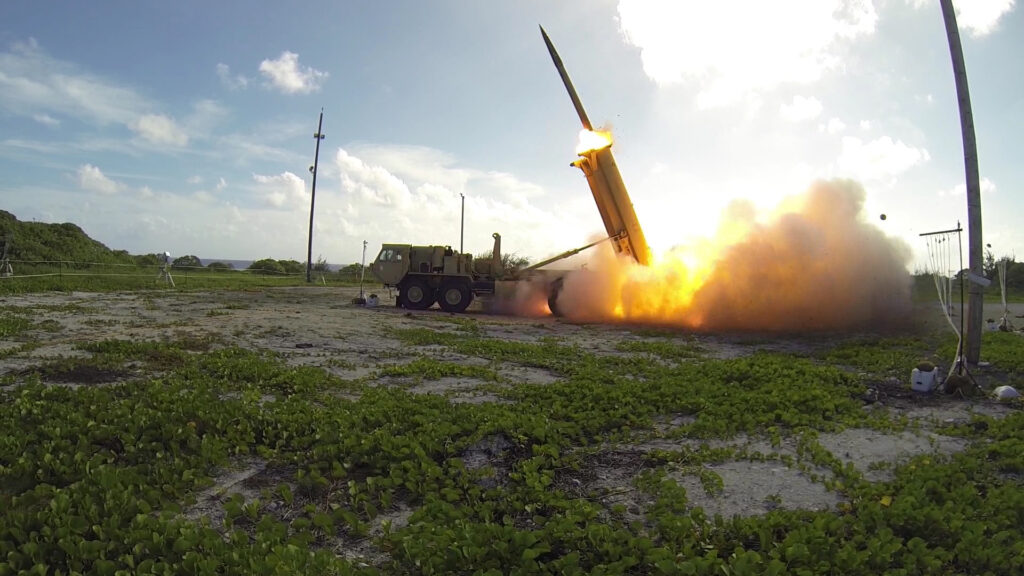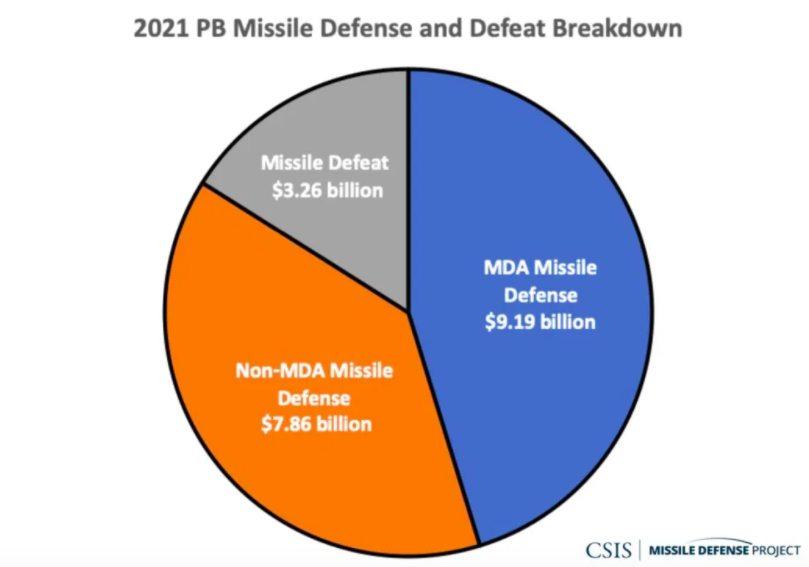
Terminal High-Altitude Area Defense (THAAD) system
WASHINGTON: Senior DoD officials and top military leaders currently are pondering how to organize future missile defense acquisition, including the possible break up of the Missile Defense Agency (MDA) by transferring its authorities to the Army, Air Force, Navy and Space Force, insiders say.
MDA’s fate is under the microscope as DoD and military leaders struggle to consolidate space acquisition since the creation of the Space Force. While no final decisions regarding missile defense acquisition have been made, DoD officials and experts say that fundamental questions about the ‘who, what and why’ of missile defense need to be resolved.
“There’s a lot more interest in space. There’s a lot more interest in countering missile threats of various kinds, and in the putting together of our various missile defeat and active missile defenses,” says Tom Karako, missile defense guru at the Center for Strategic and International Studies (CSIS) told me in a phone interview yesterday. “There’s a lot of questions there in terms of how you then go about organizing what I like to call the missile defense enterprise … so as to contend with those things,” he said.
Indeed, a key question in the internal discussions is whether MDA’s acquisition authorities will move to the Space Force once the new space acquisition secretariat is created in 2022. This could either be done by subsuming MDA en masse into the Space Force, currently headed by Gen. Jay Raymond, sources say. Or it could be done by shifting only MDA’s space-related development/acquisition authorities — such as for missile detection and tracking, but also perhaps for long-range ICBM defense — to Space Force.
If MDA’s space-related activities were to be shifted to the Space Force, this begs the follow-on question of whether its other activities ought to be turned over to the other services.
For example, the Army could be charged with acquisition and and future upgrading of the Terminal High Altitude Area Defense (THAAD) system. Indeed, some argue that already operational systems like THAAD, being used by a service, should be funded and managed by the services instead of MDA buying the systems and transferring them. On the other hand, one insider said, the Army and its sister services consistently have declined any interest in transfer of missile defense systems because it would create “a headache they don’t like to worry about” for both budget decisions and acquisition management.
DoD’s internal debate on MDA has been reflected in part in its budget decisions since the completion of the 2019 Missile Defense Review.
For example, DoD Research and Engineering Chief Mike Griffin, who currently holds oversight authority for MDA and the Space Development Agency (SDA), has endeavored to flip budgetary responsibility for development and procurement of a missile defense space-based sensor layer of Low Earth Orbit satellites to better track both ballistic and hypersonic cruise missiles from MDA to SDA in the last two budgets. SDA is slated to move under the Space Force in 2022.
MDA’s 2021 budget request once again zeros out funding for Hypersonic & Ballistic Tracking Space Sensor (HBTSS) Prototyping (under PE 1206895C / Ballistic Missile Defense System Space Programs). Funding for HBTSS is instead lumped under SDA’s $216 million budget for Space Technology Development and Prototyping (PE 1206410SDA).
As I reported extensively, Griffin has reaped the wrath of a Congress largely protective of MDA’s independence — with the House Armed Services Committee (HASC) taking him to task by name during its March 12 budget hearing. In the 2020 appropriation bill, Congress deliberately added $108 million for HBTSS back to the MDA budget, and cut funds in the SDA budget, to make the point that missile tracking and targeting is MDA’s job.
Further, the Section 1688 of the 2020 NDAA ordered DoD to contract a study by a federally funded research and development center (FFRDC) to consider alternate ways to organize MDA. This could include moving it out from Griffin’s shop to direct oversight of the Undersecretary for Acquisition and Sustainment Ellen Lord, the bill stated, or “any other official.”
The study is also charged with assessing the risks and benefits of changing MDA’s broad authorities to contract outside traditional DoD acquisition practices to “standard acquisition process pursuant to Department of Defense Instruction 5000.” (A DoD spokesperson said yesterday that there has been no decision yet on which FFRDC to charge with that study.)
This all means that any discussion of ‘breaking up’ MDA is bound to be even more politically radioactive.
“If they tried that, I’d expect to see a bipartisan display of pitchforks on Capitol Hill, and the likeness of certain DoD officials burned in effigy,” Karako said.
Nonetheless, DoD officials have told me, there are legitimate questions about MDA’s future in the face of DoD’s pivot to preparing for peer conflict with Russia and China that need to be faced head-on. Simply the one currently most acute is how best to ensure that MDA’s space activities are properly integrated and aligned with the threat — given that one of the primary drivers for the establishment of both Space Force and Space Command was concern that space acquisition had lost its way under the Air Force.
Karako, for his part, agreed that hard thinking about what DoD wants MDO to do actually is overdue. On the other hand, he said, strategic-level thinking has to be done before decisions are made with an eye to “fiefdom building.”
“Before you start cutting up the baby here,” he said bluntly, “figure out what it is you want to do. And if that grand vision exists, it hasn’t been laid out.”
DoD’s 2020 and 2021 budget requests, if read carefully, seem only to suggest the breadth of the questions being raised. For example, DoD has begun to lump together various missile-defense related efforts outside of MDA with MDA’s budget in a new category of activities it refers to as the “missile defense/defeat” mission.
DoD slated $20.3 billion for what it now calls missile defense/defeat — a sum that includes the $9.19 billion for MDA, $7.8 billion in non-MDA missile defense, and $3.26 billion for “missile defeat” — the latter referring to offensive programs to take out missile batteries “left of launch” underway by the Army, Navy and Air Force, explains CSIS’s annual study on the missile defense budget.

CSIS chart
This category includes traditional missile defense efforts in MDA, SDA, DARPA, and several military services, says the CSIS report, called “Inflection Point: Missile Defense and Defeat in the 2021 Budget.”
“It also includes activities historically associated with strategic warning and programs to defeat missiles before their launch, especially by means of hypersonic strike. Although far from being realized, this reporting method reflects a desire for a more comprehensive and integrated approach to countering various missile threats,” the study, authored by Karako and colleague Wes Rumbaugh, adds.
One DoD source cautioned against reading too much into the budget request, calling it instead an instance of “creative math” designed to deflect Congress from the fact that MDA’s budget is actually at best flat, if not on a downward trajectory, despite the Missile Defense Review’s pledge to increase DoD’s focus on the mission.
Indeed, the CSIS study finds that MDA’s top line submission for 2021 of almost $9.2 billion is “a 14 percent reduction from the $10.7 billion appropriated in 2020 but very close to the projection for 2021 in last year’s budget.” The study adds that “while the Future Years Defense Program (FYDP) projection for MDA declines for two years [to $8.9 billion] it rises again to $9.2 billion in 2024 and $9.6 billion in 2025.”

CSIS chart
The study also finds that the start of the Next Generation Interceptor (NGI), the program launched to replace the Redesigned Kill Vehicle program Griffin abruptly canceled in August, has shifted resources within the agency away from development of other future technologies and toward procurement. For example, the 2021 request zeroes out all MDA funds for development of directed energy weapons. This further serves to raise “uncertainty” about MDA’s fundamental role.
“This uncertainty is especially pronounced in areas of advanced technology, much of which has been moved out of MDA. Although NGI receives considerable funding, considerable doubt now surrounds the future of hypersonic defense, homeland cruise missile defense, directed energy, the space sensor layer, and the shape of the larger missile defense enterprise,” the study concludes.






















